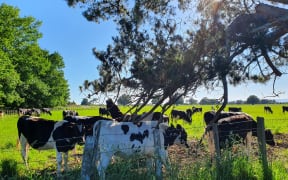Environmental activists say a new report shows the widespread destruction caused by intensive dairy farming.

Dairy cow numbers have doubled since the 1980s. Photo: 123rf
The Ministry and Stats NZ report'Our Land 2021' documents land use in recent decades.
But farmers say it also shows their environmental efforts are starting to have an impact.
The Land 2021 report is the latest in a series of stocktakes of the environment and describes the explosion of intensive farming.
Dairy cow numbers have doubled since the 1980s to six million and irrigation has nearly doubled since 2002.
Nationwide, 80 percent of sites fail soil quality tests, and the report says soil quality targets are not stopping the environment being damaged.
Native ecosystems continue to shrink, mainly through conversion to agriculture or forestry.
Amanda Larsson from Greenpeace said the report laid bare the consequences of the government's lax approach to regulating the dairy sector.
"The price of decades of inaction is that rivers are sick, soil is depleted, our drinking water is full of nitrate nitrogen, and we're spewing heaps of climate pollution out into the atmosphere that's driving more extreme weather.
"So it's a very poor report card overall."
The report said nitrogen use skyrocketed from 62,000 tonnes a year in 1991 to 452,000 a year in 2019, and 60 percent of farms used too much fertiliser.
Larsson said this was hurting soil biodiversity and polluting rivers.
"The things that are causing harm are huge amounts of fertilizer and irrigation, for example.
"The government needs to phase out synthetic nitrogen fertilizer. They need to put limits on the number of cows that correspond to what the land can handle."
However, the report describes that over the decades farming has become more efficient - with fewer farms producing more on less land.
DairyNZ's Dr David Burger said dairy's expansion in the mid-2000s caused environmental damage but it had levelled off.
"If we look at soil quality, there has not been a declining or improving trend in quality since about 1994.
"And dairy cow numbers have been quite static and even decreasing slightly since about 2014.
"At the same time, we know we've got work to do in the space."
He said it was heartening the huge efforts by farmers to clean up their practices were starting to bear fruit.
"To improve, for example, farming effluent management, exclude stock from waterways and improve farming practices generally.
"Last year the Our Land & Water national science challenge did a research report and tried to quantify what is the impact of all that work that has been done.
"And they found actually that our nitrogen loads to water would have been 45 percent higher and phosphorus would have been 98 percent higher."
The Our Land 2021 report said just 15 percent of land was ideal for growing food but the amount swallowed up by urban sprawl has increased by half since 2002.
Lincoln University BioProtection Research Centre associate professor Amanda Black said the Covid-19 pandemic showed how important it was to have a secure source of food.
"And when you take away that good land and you're only left with the scrappy land ... it's unsustainable because then you have to add so much more fertilizer, so much more other stuff to get the production levels that you need."
Black said the report showed not enough data was being collected about the impact of climate change.
"What are the indicators we need to start monitoring for climate change effects?
"And so we really need to figure out what's the best way we can measure these impacts over a long term and that's something New Zealand is deficient in is having long term monitoring, which we can draw these trends and patterns going forward."
Black said the time for business as usual was over and there needed to be some hard conversations about land use.






